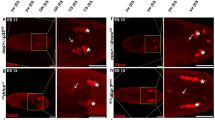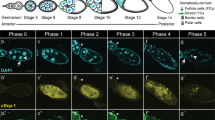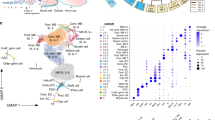Abstract
In Drosophila, vast numbers of cells undergo apoptosis during normal development. In addition, excessive apoptosis can be induced in response to a variety of stress or injury paradigms, including DNA damage, oxidative stress, nutrient deprivation, unfolded proteins and mechanical tissue damage. Two of the most commonly used methods to label apoptotic cells in Drosophila are terminal deoxynucleotidyl transferase-mediated dUTP nick-end labeling (TUNEL) for fixed tissues and acridine orange (AO) staining for live embryos or tissues. Here, we describe protocols for labeling apoptotic cells in Drosophila embryos and adult male gonads. Slightly modified protocols can also be applied for other Drosophila tissues. The AO protocol is quick, simple and allows real-time imaging of doomed cells in live tissues. However, it is difficult to combine with conventional counterstains or Ab labeling. On the other hand, this functionality is readily afforded by the TUNEL protocol, which permits the detection of apoptotic cells in fixed tissues. These staining procedures can be completed in 1–2 d.
This is a preview of subscription content, access via your institution
Access options
Subscribe to this journal
Receive 12 print issues and online access
$259.00 per year
only $21.58 per issue
Buy this article
- Purchase on Springer Link
- Instant access to full article PDF
Prices may be subject to local taxes which are calculated during checkout



Similar content being viewed by others
References
McCall, K. & Steller, H. Facing death in the fly: genetic analysis of apoptosis in Drosophila. Trends Genet. 13, 222–226 (1997).
Jacobson, M.D., Weil, M. & Raff, M.C. Programmed cell death in animal development. Cell 88, 347–354 (1997).
Hengartner, M.O. The biochemistry of apoptosis. Nature 407, 770–776 (2000).
Meier, P., Finch, A. & Evan, G. Apoptosis in development. Nature 407, 796–801 (2000).
Baehrecke, E.H. How death shapes life during development. Nat. Rev. Mol. Cell Biol. 3, 779–787 (2002).
Nelson, D.A. & White, E. Exploiting different ways to die. Genes Dev. 18, 1223–1226 (2004).
Kornbluth, S. & White, K. Apoptosis in Drosophila: neither fish nor fowl (nor man, nor worm). J. Cell Sci. 118, 1779–1787 (2005).
Baum, J.S., St George, J.P. & McCall, K. Programmed cell death in the germline. Semin. Cell Dev. Biol. 16, 245–259 (2005).
Kerr, J.F.R. & Harmon, B.V. in Apoptosis: Molecular Basis of Cell Death in Definition and Incidence of Apoptosis: An Historical Perspective 5–29 (Cold Spring Harbor Laboratory Press, Cold Spring Harbor, NY, 1991).
Gavrieli, Y., Sherman, Y. & Ben-Sasson, S.A. Identification of programmed cell death in situ via specific labeling of nuclear DNA fragmentation. J. Cell Biol. 119, 493–501 (1992).
Negoescu, A. et al. In situ apoptotic cell labeling by the TUNEL method: improvement and evaluation on cell preparations. J. Histochem. Cytochem. 44, 959–968 (1996).
Labat-Moleur, F. et al. TUNEL apoptotic cell detection in tissue sections: critical evaluation and improvement. J. Histochem. Cytochem. 46, 327–334 (1998).
Perry, S.W., Epstein, L.G. & Gelbard, H.A. Simultaneous in situ detection of apoptosis and necrosis in monolayer cultures by TUNEL and trypan blue staining. Biotechniques 22, 1102–1106 (1997).
Laberge, R.M. & Boissonneault, G. On the nature and origin of DNA strand breaks in elongating spermatids. Biol. Reprod. 73, 289–296 (2005).
White, K. et al. Genetic control of programmed cell death in Drosophila. Science 264, 677–683 (1994).
Mergliano, J. & Minden, J.S. Caspase-independent cell engulfment mirrors cell death pattern in Drosophila embryos. Development 130, 5779–5789 (2003).
Spreij, T.E. Cell death during the development of imaginal discs of Calliphora erythrocephala. Netherlands J. Zool. 21, 221–264 (1971).
Wolff, T. & Ready, D.F. Cell death in normal and rough eye mutants of Drosophila. Development 113, 825–839 (1991).
Abrams, J.M., White, K., Fessler, L.I. & Steller, H. Programmed cell death during Drosophila embryogenesis. Development 117, 29–43 (1993).
Delic, J., Coppey, J., Magdelenat, H. & Coppey-Moisan, M. Impossibility of acridine orange intercalation in nuclear DNA of the living cell. Exp. Cell Res. 194, 147–153 (1991).
Arama, E., Agapite, J. & Steller, H. Caspase activity and a specific cytochrome C are required for sperm differentiation in Drosophila. Dev. Cell 4, 687–697 (2003).
Arama, E., Bader, M., Srivastava, M., Bergmann, A. & Steller, H. The two Drosophila cytochrome C proteins can function in both respiration and caspase activation. EMBO J. 25, 232–243 (2006).
Meistrich, M.L., Trostle-Weige, P.K., Lin, R., Bhatnagar, Y.M. & Allis, C.D. Highly acetylated H4 is associated with histone displacement in rat spermatids. Mol. Reprod. Dev. 31, 170–181 (1992).
Rastelli, L. & Kuroda, M.I. An analysis of maleless and histone H4 acetylation in Drosophila melanogaster spermatogenesis. Mech. Dev. 71, 107–117 (1998).
Acknowledgements
We thank C. Gafuik and G. Rieckhof for critically reading the manuscript and M. Bader for help with Figure 3. E.A. was a fellow of the Charles H. Revson Foundation and H.S. is an investigator with the Howard Hughes Medical Institute. Part of this work was supported by NIH grant RO1 GM60124 to H.S.
Author information
Authors and Affiliations
Corresponding author
Ethics declarations
Competing interests
The authors declare no competing financial interests.
Rights and permissions
About this article
Cite this article
Arama, E., Steller, H. Detection of apoptosis by terminal deoxynucleotidyl transferase-mediated dUTP nick-end labeling and acridine orange in Drosophila embryos and adult male gonads. Nat Protoc 1, 1725–1731 (2006). https://doi.org/10.1038/nprot.2006.235
Published:
Issue Date:
DOI: https://doi.org/10.1038/nprot.2006.235
This article is cited by
-
Mutation and apoptosis are well-coordinated for protecting against DNA damage-inducing toxicity in Drosophila
Genes and Environment (2023)
-
Sensitive-stage embryo irradiation affects embryonic neuroblasts and adult motor function
Molecular & Cellular Toxicology (2022)
-
Peripheral Expression of Mutant Huntingtin is a Critical Determinant of Weight Loss and Metabolic Disturbances in Huntington’s Disease
Scientific Reports (2019)
-
Caspases maintain tissue integrity by an apoptosis-independent inhibition of cell migration and invasion
Nature Communications (2018)
-
Mutations that prevent or mimic persistent post-translational modifications of the histone H3 globular domain cause lethality and growth defects in Drosophila
Epigenetics & Chromatin (2016)
Comments
By submitting a comment you agree to abide by our Terms and Community Guidelines. If you find something abusive or that does not comply with our terms or guidelines please flag it as inappropriate.



